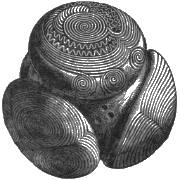NMS Archaeology Object 724067: X.2014.204 - Chisel
Description
Summary
Bronze chisel, Middle Bronze Age, found at Bonchester Bridge, Roxburghshire, Scotland
Accession Number
X.2014.204
Other references
| Classification Number | X.DC 160 |
|---|
Original description
Middle Bronze Age bronze chisel found at Bonchester Bridge, Roxburghshire. X.2014.204 = X.DC 160 Middle Bronze Age bronze chisel found at Bonchester Bridge, Roxburghshire. Copper alloy. [see CO TT/1/14 where referred to as Hawick] Site: Bonchester Bridge, Roxburghshire, Scotland, EUROPE. Trevor Cowie notes, 9 October 2015: Bronze flanged chisel with elongated tapering body and cutting edge set adzewise to the flanges; butt rounded but heavily worn; from the butt, proportionately short, low flanges extend approximately one third of the length of the body, merging with the sides in line with gentle sloping stops; the ‘business end’ of the chisel is elongated, changing from a robust square- to more slender rectangular-sectioned body as it diverges to meet the worn tips of the unexpanded cutting edge. Generally a matt green/brown colour; in sound condition despite very severe corrosion; however, most of the original surface has been lost apart from the mid-section and part of the area protected by the remains of the flanges. Dimensions: L 106.1mm; W (cutting edge) 14.25mm; W (butt) 16mm. Weight: 71.3g. This MBA flanged chisel was found near Bonchester Bridge, Hobkirk. Only a small number of Bronze Age flanged chisels are known from Scotland so that new and well-provenanced discoveries are a welcome addition to the limited inventory of finds. Coles (1964, 117 & 146) listed six examples of chisels with the blades set adzewise to the flanges and to these can be added a discovery from Boreland near Lockerbie discovered in 1995 and now also the new find from Bonchester Bridge. However as Joanna Close-Brooks (1975, 195) has pointed out, there are a number of examples of flanged tools of small size and slender proportions in which the blade is set axewise and which seem to be sufficiently distinct from flanged axes proper to be considered as probable chisels too. Given the small overall numbers of both forms, our picture of the Middle Bronze Age tool kit may not be fully representative, but it does seem likely that the appearance of flanged chisels is closely related to the development of flanged axes, suggesting a broad date range from the 16th to the 12th centuries BC, until their eventual replacement by socketed tools. The present rather corroded condition of the object belies the fact that this would originally have been a robust tool of elegant design. While their suitability for light woodworking is not in doubt, precisely how the various flanged tools were used is uncertain. Close-Brooks noted that the absence of a stop-ridge on some of the tools might have resulted in the splitting of wooden hafts if struck with a mallet in the manner of a modern chisel; she went on to suggest that practical experiments with replica tools might throw further light on their method of use (ibid, 195). Further metrical analysis may also help to define these categories of tool with greater precision. Close-Brooks, J 1975 `Two bronzes from Caithness', Proc Soc Antiq Scot, 106 (1975), 194-195; Coles, J M 1964 `Scottish Middle Bronze Age metalwork', Proc Soc Antiq Scot, 97 (1963-4), 82-156.
Associated person/people (e.g. excavator/former collection)
None
Discovery / field collection
Date of discovery
Not recorded
Method (e.g. excavation)
Not recorded
Place (i.e. location of discovery)
Bonchester Bridge, Roxburghshire, Scotland, Northern Europe
Grid reference
Not recorded
Acquisition
Acquisition date
2014
Acquisition source (i.e. name of donor)
Not recorded
Acquisition source role (e.g. donor)
Not recorded
Image
None
Identifiers and Links to Other Records
This record has no links! Would you like to help?
| Identifier / External Link | Linked Record | Status | Comment |
|---|---|---|---|
| NMS Accession Number: X.2014.204 | No linked record | Identifier supplied by NMS |
This area is visible only to logged in users.
